Business and Business Environment: Report on Organisations and Factors
VerifiedAdded on 2020/10/05
|16
|5538
|463
Report
AI Summary
This report offers a comprehensive analysis of the business environment, focusing on different types of organizations such as private, public, and voluntary sectors, with examples including Lego, UNICEF, and the Bank of England. It explores their legal structures, purposes, sizes, and scopes. The report delves into various organizational structures like line, staff and functional authority, and divisional structures, examining their relationships with business objectives. Furthermore, it includes a PESTLE analysis to identify macro-environmental factors influencing business operations and a SWOT analysis to assess strengths, weaknesses, opportunities, and threats. The report concludes by summarizing key findings and providing references for further study, offering a detailed overview of the complexities within the business landscape.
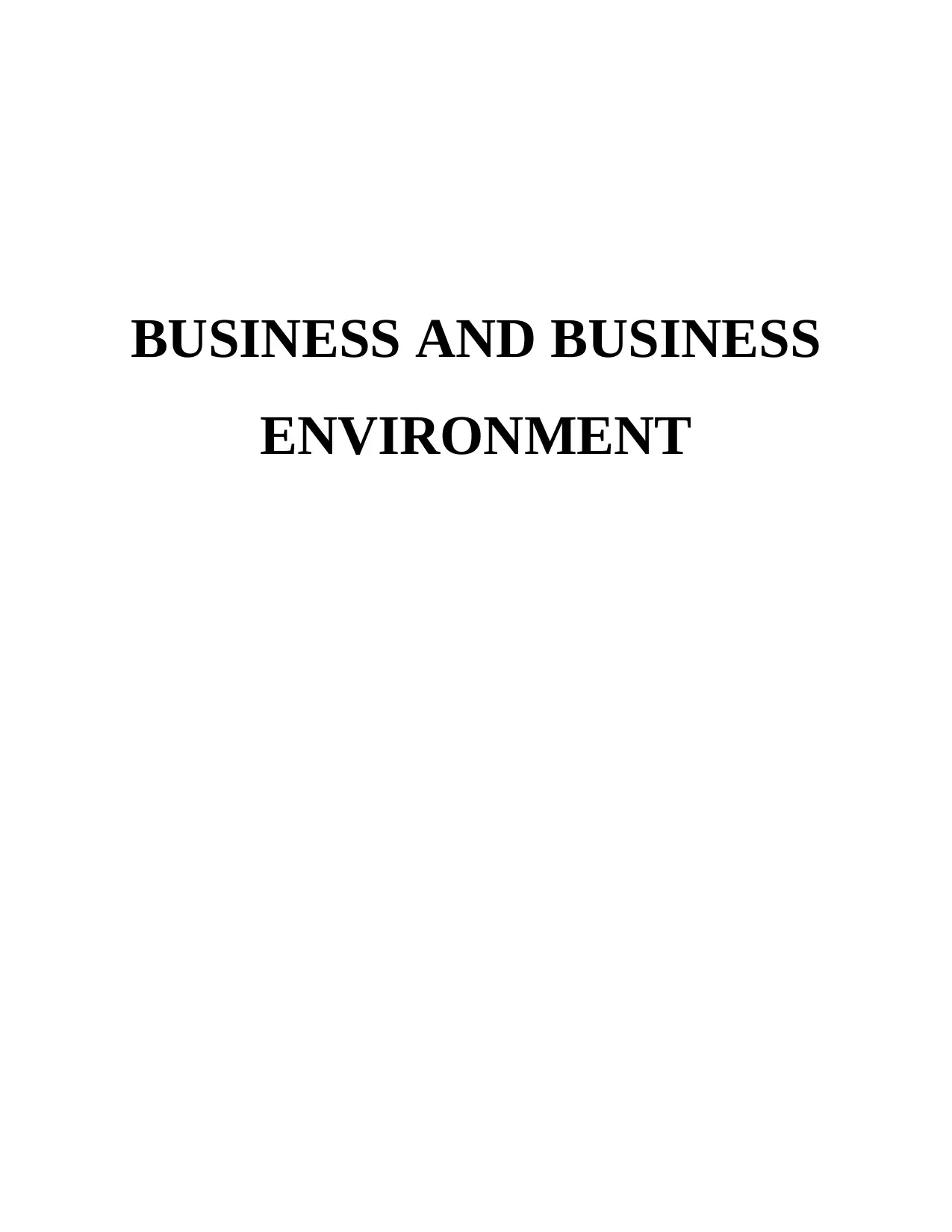
BUSINESS AND BUSINESS
ENVIRONMENT
ENVIRONMENT
Paraphrase This Document
Need a fresh take? Get an instant paraphrase of this document with our AI Paraphraser
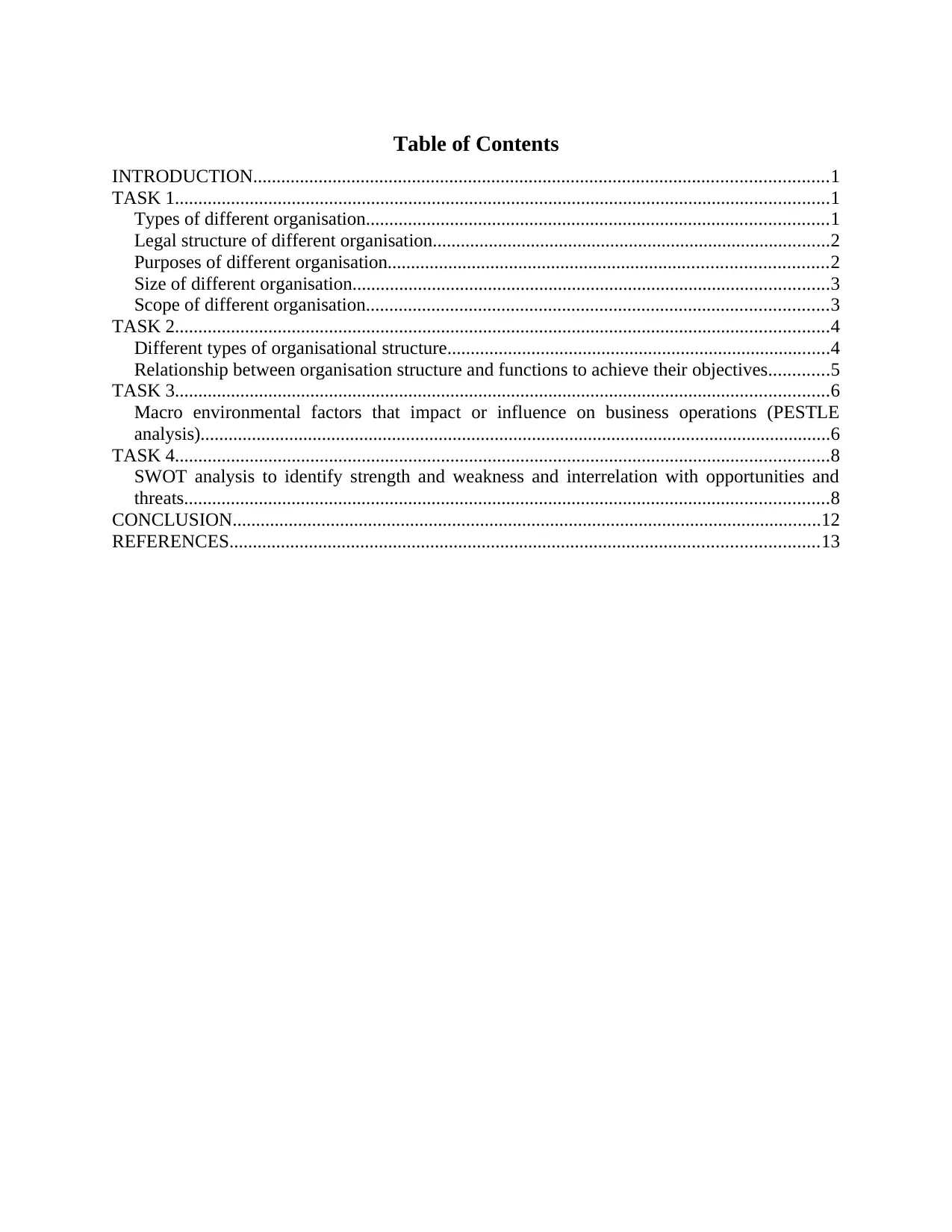
Table of Contents
INTRODUCTION...........................................................................................................................1
TASK 1............................................................................................................................................1
Types of different organisation...................................................................................................1
Legal structure of different organisation.....................................................................................2
Purposes of different organisation..............................................................................................2
Size of different organisation......................................................................................................3
Scope of different organisation...................................................................................................3
TASK 2............................................................................................................................................4
Different types of organisational structure..................................................................................4
Relationship between organisation structure and functions to achieve their objectives.............5
TASK 3............................................................................................................................................6
Macro environmental factors that impact or influence on business operations (PESTLE
analysis).......................................................................................................................................6
TASK 4............................................................................................................................................8
SWOT analysis to identify strength and weakness and interrelation with opportunities and
threats..........................................................................................................................................8
CONCLUSION..............................................................................................................................12
REFERENCES..............................................................................................................................13
INTRODUCTION...........................................................................................................................1
TASK 1............................................................................................................................................1
Types of different organisation...................................................................................................1
Legal structure of different organisation.....................................................................................2
Purposes of different organisation..............................................................................................2
Size of different organisation......................................................................................................3
Scope of different organisation...................................................................................................3
TASK 2............................................................................................................................................4
Different types of organisational structure..................................................................................4
Relationship between organisation structure and functions to achieve their objectives.............5
TASK 3............................................................................................................................................6
Macro environmental factors that impact or influence on business operations (PESTLE
analysis).......................................................................................................................................6
TASK 4............................................................................................................................................8
SWOT analysis to identify strength and weakness and interrelation with opportunities and
threats..........................................................................................................................................8
CONCLUSION..............................................................................................................................12
REFERENCES..............................................................................................................................13
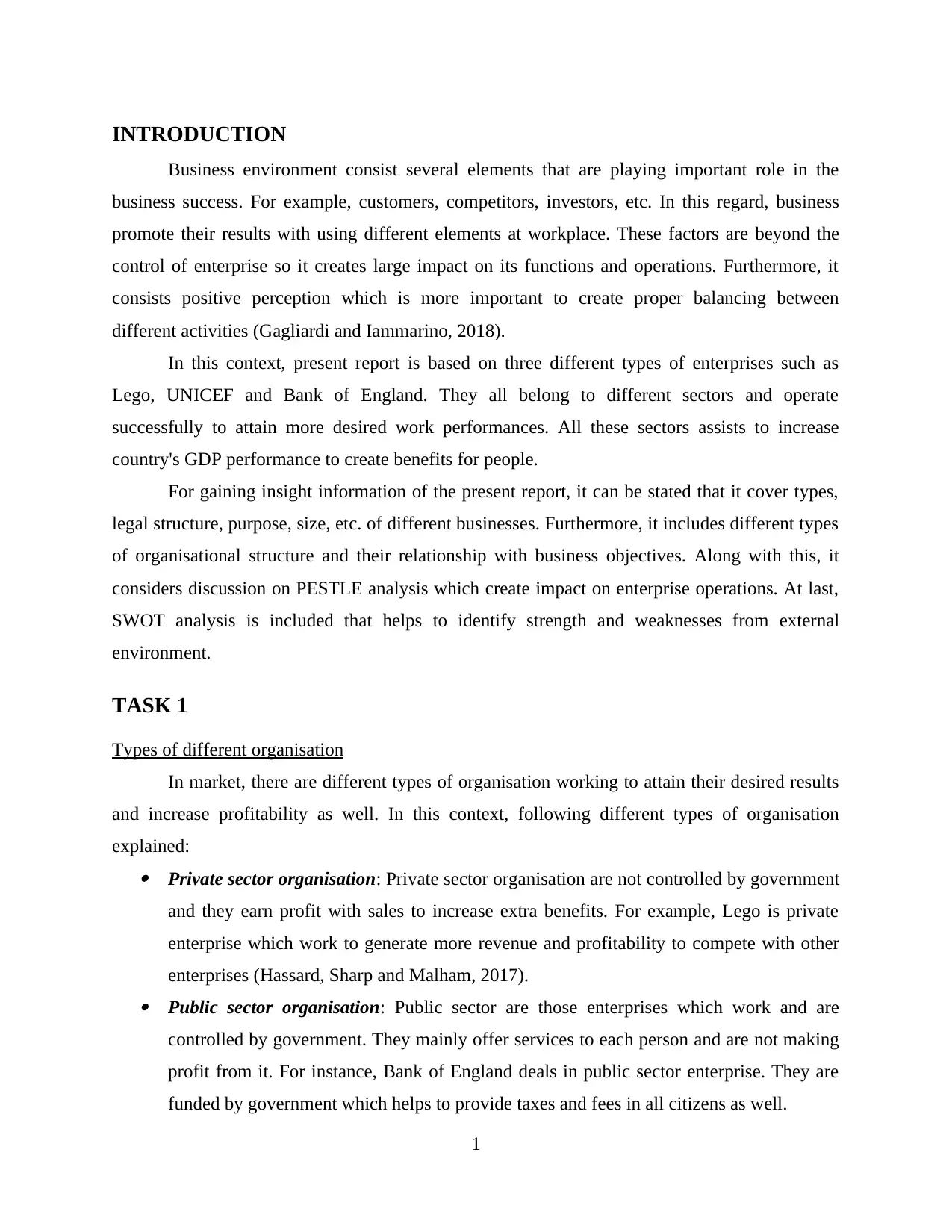
INTRODUCTION
Business environment consist several elements that are playing important role in the
business success. For example, customers, competitors, investors, etc. In this regard, business
promote their results with using different elements at workplace. These factors are beyond the
control of enterprise so it creates large impact on its functions and operations. Furthermore, it
consists positive perception which is more important to create proper balancing between
different activities (Gagliardi and Iammarino, 2018).
In this context, present report is based on three different types of enterprises such as
Lego, UNICEF and Bank of England. They all belong to different sectors and operate
successfully to attain more desired work performances. All these sectors assists to increase
country's GDP performance to create benefits for people.
For gaining insight information of the present report, it can be stated that it cover types,
legal structure, purpose, size, etc. of different businesses. Furthermore, it includes different types
of organisational structure and their relationship with business objectives. Along with this, it
considers discussion on PESTLE analysis which create impact on enterprise operations. At last,
SWOT analysis is included that helps to identify strength and weaknesses from external
environment.
TASK 1
Types of different organisation
In market, there are different types of organisation working to attain their desired results
and increase profitability as well. In this context, following different types of organisation
explained: Private sector organisation: Private sector organisation are not controlled by government
and they earn profit with sales to increase extra benefits. For example, Lego is private
enterprise which work to generate more revenue and profitability to compete with other
enterprises (Hassard, Sharp and Malham, 2017). Public sector organisation: Public sector are those enterprises which work and are
controlled by government. They mainly offer services to each person and are not making
profit from it. For instance, Bank of England deals in public sector enterprise. They are
funded by government which helps to provide taxes and fees in all citizens as well.
1
Business environment consist several elements that are playing important role in the
business success. For example, customers, competitors, investors, etc. In this regard, business
promote their results with using different elements at workplace. These factors are beyond the
control of enterprise so it creates large impact on its functions and operations. Furthermore, it
consists positive perception which is more important to create proper balancing between
different activities (Gagliardi and Iammarino, 2018).
In this context, present report is based on three different types of enterprises such as
Lego, UNICEF and Bank of England. They all belong to different sectors and operate
successfully to attain more desired work performances. All these sectors assists to increase
country's GDP performance to create benefits for people.
For gaining insight information of the present report, it can be stated that it cover types,
legal structure, purpose, size, etc. of different businesses. Furthermore, it includes different types
of organisational structure and their relationship with business objectives. Along with this, it
considers discussion on PESTLE analysis which create impact on enterprise operations. At last,
SWOT analysis is included that helps to identify strength and weaknesses from external
environment.
TASK 1
Types of different organisation
In market, there are different types of organisation working to attain their desired results
and increase profitability as well. In this context, following different types of organisation
explained: Private sector organisation: Private sector organisation are not controlled by government
and they earn profit with sales to increase extra benefits. For example, Lego is private
enterprise which work to generate more revenue and profitability to compete with other
enterprises (Hassard, Sharp and Malham, 2017). Public sector organisation: Public sector are those enterprises which work and are
controlled by government. They mainly offer services to each person and are not making
profit from it. For instance, Bank of England deals in public sector enterprise. They are
funded by government which helps to provide taxes and fees in all citizens as well.
1
⊘ This is a preview!⊘
Do you want full access?
Subscribe today to unlock all pages.

Trusted by 1+ million students worldwide
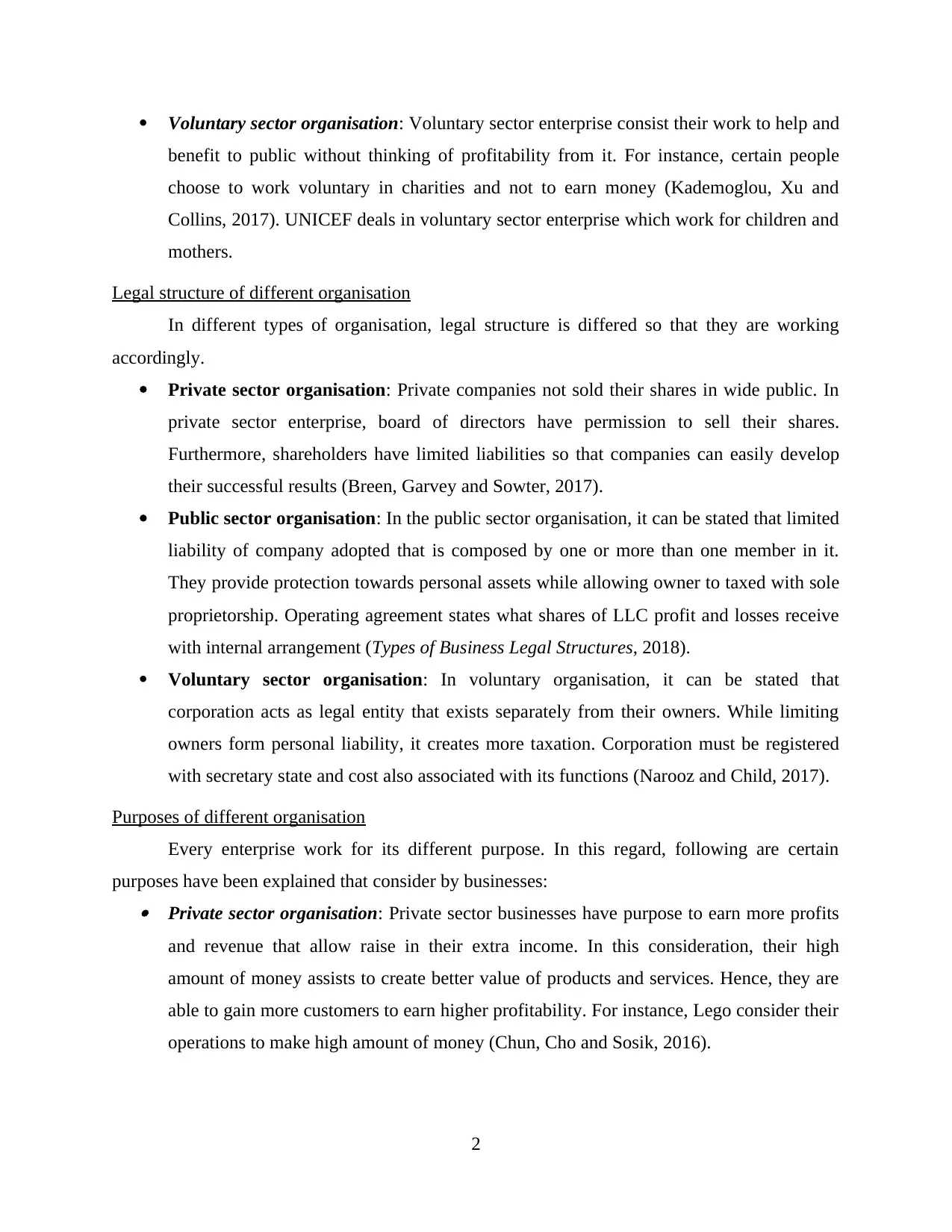
Voluntary sector organisation: Voluntary sector enterprise consist their work to help and
benefit to public without thinking of profitability from it. For instance, certain people
choose to work voluntary in charities and not to earn money (Kademoglou, Xu and
Collins, 2017). UNICEF deals in voluntary sector enterprise which work for children and
mothers.
Legal structure of different organisation
In different types of organisation, legal structure is differed so that they are working
accordingly.
Private sector organisation: Private companies not sold their shares in wide public. In
private sector enterprise, board of directors have permission to sell their shares.
Furthermore, shareholders have limited liabilities so that companies can easily develop
their successful results (Breen, Garvey and Sowter, 2017).
Public sector organisation: In the public sector organisation, it can be stated that limited
liability of company adopted that is composed by one or more than one member in it.
They provide protection towards personal assets while allowing owner to taxed with sole
proprietorship. Operating agreement states what shares of LLC profit and losses receive
with internal arrangement (Types of Business Legal Structures, 2018).
Voluntary sector organisation: In voluntary organisation, it can be stated that
corporation acts as legal entity that exists separately from their owners. While limiting
owners form personal liability, it creates more taxation. Corporation must be registered
with secretary state and cost also associated with its functions (Narooz and Child, 2017).
Purposes of different organisation
Every enterprise work for its different purpose. In this regard, following are certain
purposes have been explained that consider by businesses: Private sector organisation: Private sector businesses have purpose to earn more profits
and revenue that allow raise in their extra income. In this consideration, their high
amount of money assists to create better value of products and services. Hence, they are
able to gain more customers to earn higher profitability. For instance, Lego consider their
operations to make high amount of money (Chun, Cho and Sosik, 2016).
2
benefit to public without thinking of profitability from it. For instance, certain people
choose to work voluntary in charities and not to earn money (Kademoglou, Xu and
Collins, 2017). UNICEF deals in voluntary sector enterprise which work for children and
mothers.
Legal structure of different organisation
In different types of organisation, legal structure is differed so that they are working
accordingly.
Private sector organisation: Private companies not sold their shares in wide public. In
private sector enterprise, board of directors have permission to sell their shares.
Furthermore, shareholders have limited liabilities so that companies can easily develop
their successful results (Breen, Garvey and Sowter, 2017).
Public sector organisation: In the public sector organisation, it can be stated that limited
liability of company adopted that is composed by one or more than one member in it.
They provide protection towards personal assets while allowing owner to taxed with sole
proprietorship. Operating agreement states what shares of LLC profit and losses receive
with internal arrangement (Types of Business Legal Structures, 2018).
Voluntary sector organisation: In voluntary organisation, it can be stated that
corporation acts as legal entity that exists separately from their owners. While limiting
owners form personal liability, it creates more taxation. Corporation must be registered
with secretary state and cost also associated with its functions (Narooz and Child, 2017).
Purposes of different organisation
Every enterprise work for its different purpose. In this regard, following are certain
purposes have been explained that consider by businesses: Private sector organisation: Private sector businesses have purpose to earn more profits
and revenue that allow raise in their extra income. In this consideration, their high
amount of money assists to create better value of products and services. Hence, they are
able to gain more customers to earn higher profitability. For instance, Lego consider their
operations to make high amount of money (Chun, Cho and Sosik, 2016).
2
Paraphrase This Document
Need a fresh take? Get an instant paraphrase of this document with our AI Paraphraser
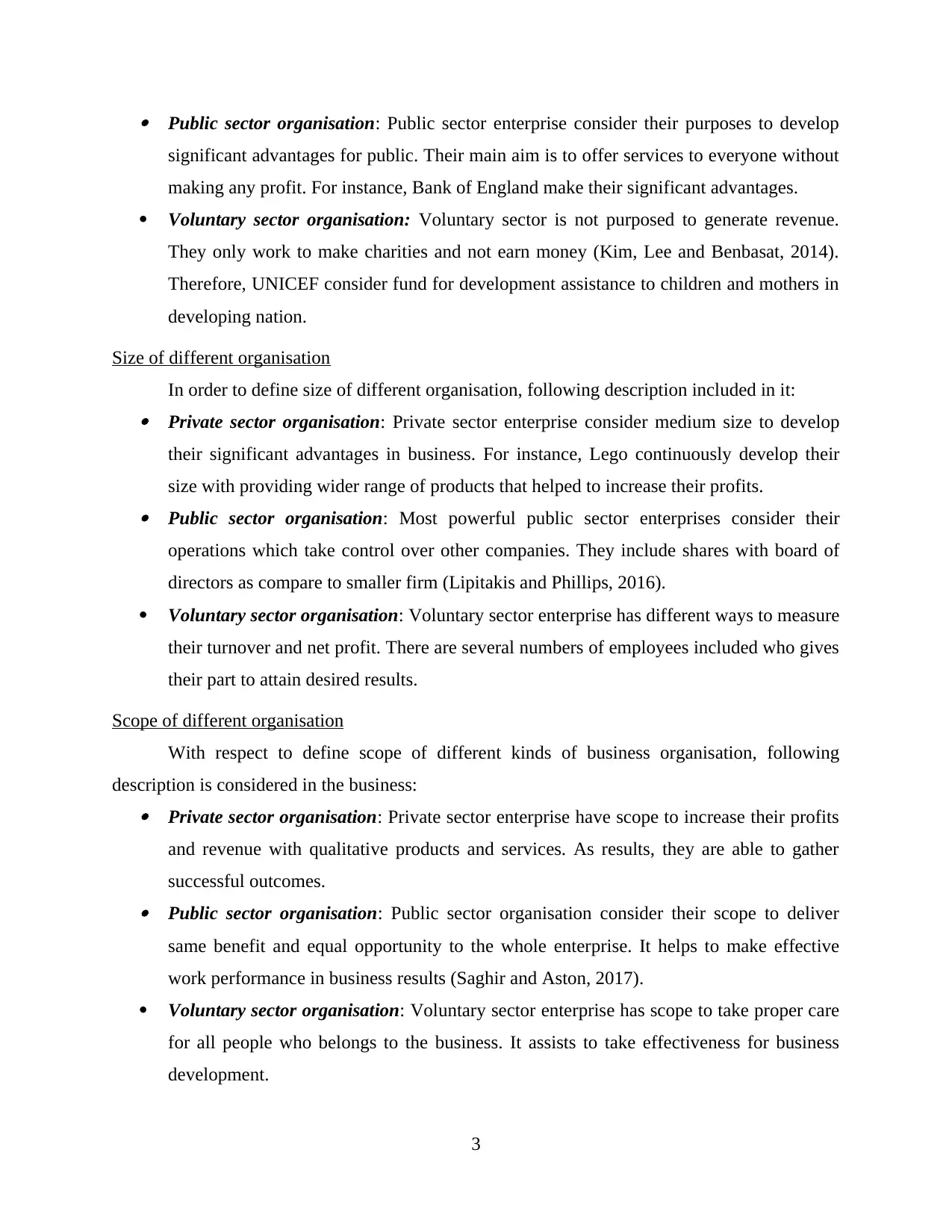
Public sector organisation: Public sector enterprise consider their purposes to develop
significant advantages for public. Their main aim is to offer services to everyone without
making any profit. For instance, Bank of England make their significant advantages.
Voluntary sector organisation: Voluntary sector is not purposed to generate revenue.
They only work to make charities and not earn money (Kim, Lee and Benbasat, 2014).
Therefore, UNICEF consider fund for development assistance to children and mothers in
developing nation.
Size of different organisation
In order to define size of different organisation, following description included in it: Private sector organisation: Private sector enterprise consider medium size to develop
their significant advantages in business. For instance, Lego continuously develop their
size with providing wider range of products that helped to increase their profits. Public sector organisation: Most powerful public sector enterprises consider their
operations which take control over other companies. They include shares with board of
directors as compare to smaller firm (Lipitakis and Phillips, 2016).
Voluntary sector organisation: Voluntary sector enterprise has different ways to measure
their turnover and net profit. There are several numbers of employees included who gives
their part to attain desired results.
Scope of different organisation
With respect to define scope of different kinds of business organisation, following
description is considered in the business: Private sector organisation: Private sector enterprise have scope to increase their profits
and revenue with qualitative products and services. As results, they are able to gather
successful outcomes. Public sector organisation: Public sector organisation consider their scope to deliver
same benefit and equal opportunity to the whole enterprise. It helps to make effective
work performance in business results (Saghir and Aston, 2017).
Voluntary sector organisation: Voluntary sector enterprise has scope to take proper care
for all people who belongs to the business. It assists to take effectiveness for business
development.
3
significant advantages for public. Their main aim is to offer services to everyone without
making any profit. For instance, Bank of England make their significant advantages.
Voluntary sector organisation: Voluntary sector is not purposed to generate revenue.
They only work to make charities and not earn money (Kim, Lee and Benbasat, 2014).
Therefore, UNICEF consider fund for development assistance to children and mothers in
developing nation.
Size of different organisation
In order to define size of different organisation, following description included in it: Private sector organisation: Private sector enterprise consider medium size to develop
their significant advantages in business. For instance, Lego continuously develop their
size with providing wider range of products that helped to increase their profits. Public sector organisation: Most powerful public sector enterprises consider their
operations which take control over other companies. They include shares with board of
directors as compare to smaller firm (Lipitakis and Phillips, 2016).
Voluntary sector organisation: Voluntary sector enterprise has different ways to measure
their turnover and net profit. There are several numbers of employees included who gives
their part to attain desired results.
Scope of different organisation
With respect to define scope of different kinds of business organisation, following
description is considered in the business: Private sector organisation: Private sector enterprise have scope to increase their profits
and revenue with qualitative products and services. As results, they are able to gather
successful outcomes. Public sector organisation: Public sector organisation consider their scope to deliver
same benefit and equal opportunity to the whole enterprise. It helps to make effective
work performance in business results (Saghir and Aston, 2017).
Voluntary sector organisation: Voluntary sector enterprise has scope to take proper care
for all people who belongs to the business. It assists to take effectiveness for business
development.
3
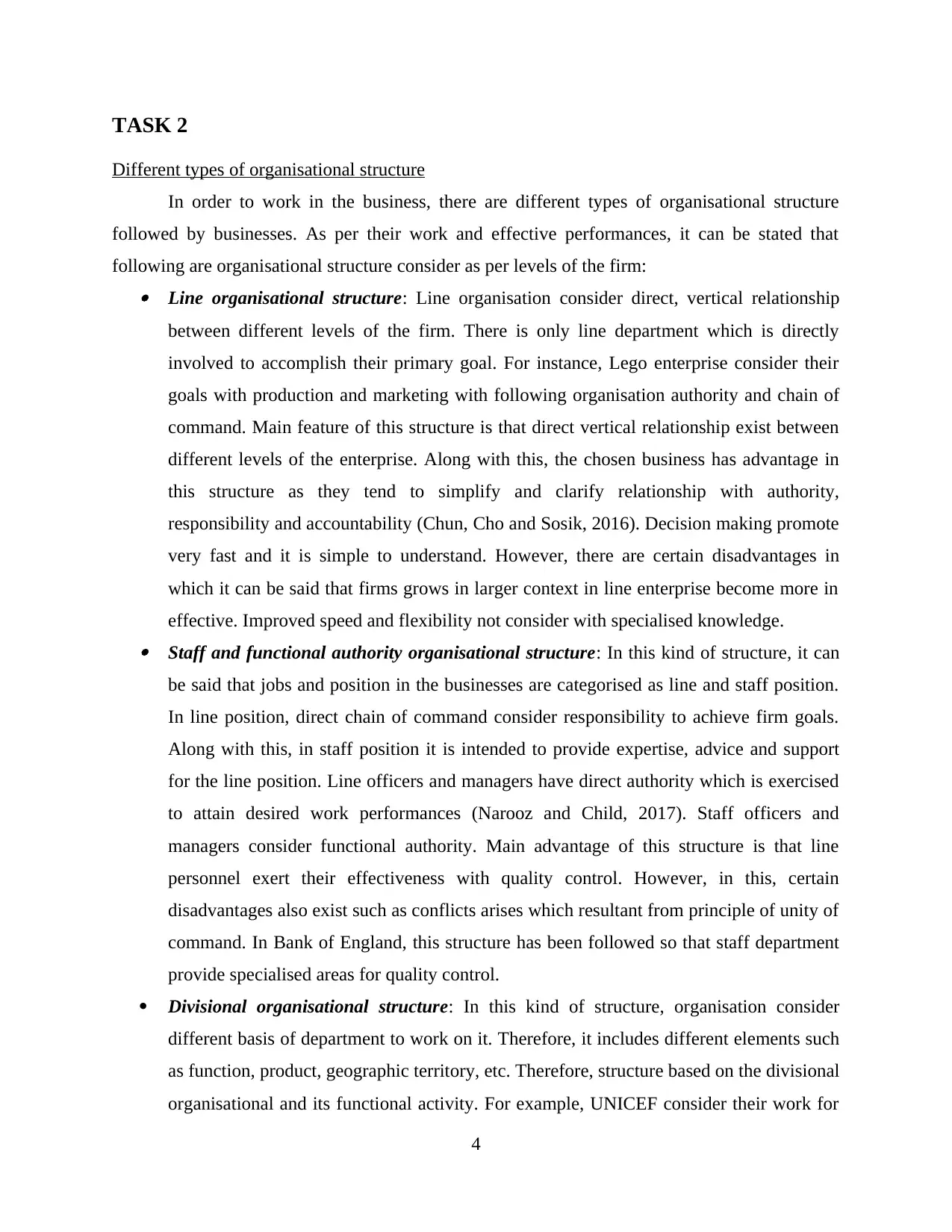
TASK 2
Different types of organisational structure
In order to work in the business, there are different types of organisational structure
followed by businesses. As per their work and effective performances, it can be stated that
following are organisational structure consider as per levels of the firm: Line organisational structure: Line organisation consider direct, vertical relationship
between different levels of the firm. There is only line department which is directly
involved to accomplish their primary goal. For instance, Lego enterprise consider their
goals with production and marketing with following organisation authority and chain of
command. Main feature of this structure is that direct vertical relationship exist between
different levels of the enterprise. Along with this, the chosen business has advantage in
this structure as they tend to simplify and clarify relationship with authority,
responsibility and accountability (Chun, Cho and Sosik, 2016). Decision making promote
very fast and it is simple to understand. However, there are certain disadvantages in
which it can be said that firms grows in larger context in line enterprise become more in
effective. Improved speed and flexibility not consider with specialised knowledge. Staff and functional authority organisational structure: In this kind of structure, it can
be said that jobs and position in the businesses are categorised as line and staff position.
In line position, direct chain of command consider responsibility to achieve firm goals.
Along with this, in staff position it is intended to provide expertise, advice and support
for the line position. Line officers and managers have direct authority which is exercised
to attain desired work performances (Narooz and Child, 2017). Staff officers and
managers consider functional authority. Main advantage of this structure is that line
personnel exert their effectiveness with quality control. However, in this, certain
disadvantages also exist such as conflicts arises which resultant from principle of unity of
command. In Bank of England, this structure has been followed so that staff department
provide specialised areas for quality control.
Divisional organisational structure: In this kind of structure, organisation consider
different basis of department to work on it. Therefore, it includes different elements such
as function, product, geographic territory, etc. Therefore, structure based on the divisional
organisational and its functional activity. For example, UNICEF consider their work for
4
Different types of organisational structure
In order to work in the business, there are different types of organisational structure
followed by businesses. As per their work and effective performances, it can be stated that
following are organisational structure consider as per levels of the firm: Line organisational structure: Line organisation consider direct, vertical relationship
between different levels of the firm. There is only line department which is directly
involved to accomplish their primary goal. For instance, Lego enterprise consider their
goals with production and marketing with following organisation authority and chain of
command. Main feature of this structure is that direct vertical relationship exist between
different levels of the enterprise. Along with this, the chosen business has advantage in
this structure as they tend to simplify and clarify relationship with authority,
responsibility and accountability (Chun, Cho and Sosik, 2016). Decision making promote
very fast and it is simple to understand. However, there are certain disadvantages in
which it can be said that firms grows in larger context in line enterprise become more in
effective. Improved speed and flexibility not consider with specialised knowledge. Staff and functional authority organisational structure: In this kind of structure, it can
be said that jobs and position in the businesses are categorised as line and staff position.
In line position, direct chain of command consider responsibility to achieve firm goals.
Along with this, in staff position it is intended to provide expertise, advice and support
for the line position. Line officers and managers have direct authority which is exercised
to attain desired work performances (Narooz and Child, 2017). Staff officers and
managers consider functional authority. Main advantage of this structure is that line
personnel exert their effectiveness with quality control. However, in this, certain
disadvantages also exist such as conflicts arises which resultant from principle of unity of
command. In Bank of England, this structure has been followed so that staff department
provide specialised areas for quality control.
Divisional organisational structure: In this kind of structure, organisation consider
different basis of department to work on it. Therefore, it includes different elements such
as function, product, geographic territory, etc. Therefore, structure based on the divisional
organisational and its functional activity. For example, UNICEF consider their work for
4
⊘ This is a preview!⊘
Do you want full access?
Subscribe today to unlock all pages.

Trusted by 1+ million students worldwide
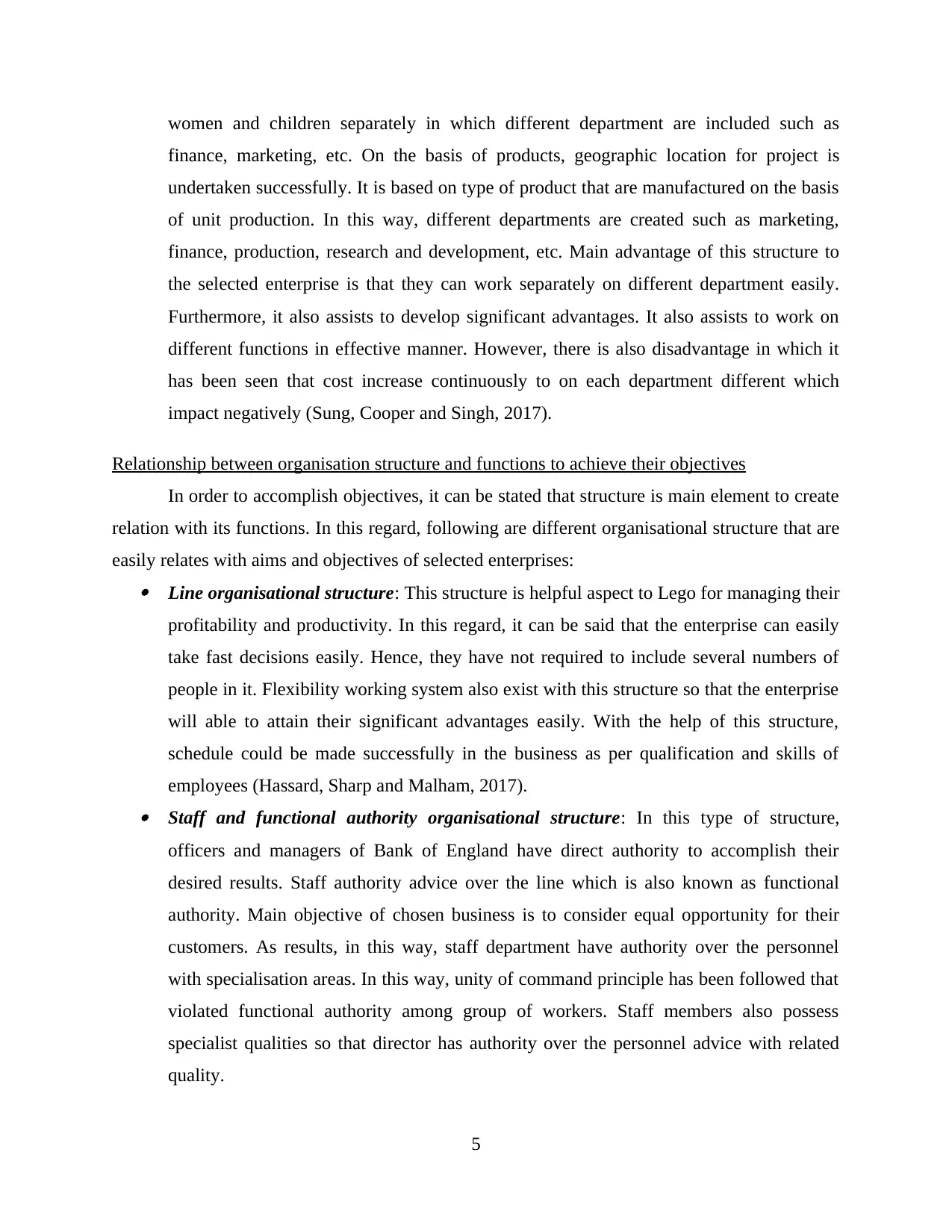
women and children separately in which different department are included such as
finance, marketing, etc. On the basis of products, geographic location for project is
undertaken successfully. It is based on type of product that are manufactured on the basis
of unit production. In this way, different departments are created such as marketing,
finance, production, research and development, etc. Main advantage of this structure to
the selected enterprise is that they can work separately on different department easily.
Furthermore, it also assists to develop significant advantages. It also assists to work on
different functions in effective manner. However, there is also disadvantage in which it
has been seen that cost increase continuously to on each department different which
impact negatively (Sung, Cooper and Singh, 2017).
Relationship between organisation structure and functions to achieve their objectives
In order to accomplish objectives, it can be stated that structure is main element to create
relation with its functions. In this regard, following are different organisational structure that are
easily relates with aims and objectives of selected enterprises: Line organisational structure: This structure is helpful aspect to Lego for managing their
profitability and productivity. In this regard, it can be said that the enterprise can easily
take fast decisions easily. Hence, they have not required to include several numbers of
people in it. Flexibility working system also exist with this structure so that the enterprise
will able to attain their significant advantages easily. With the help of this structure,
schedule could be made successfully in the business as per qualification and skills of
employees (Hassard, Sharp and Malham, 2017). Staff and functional authority organisational structure: In this type of structure,
officers and managers of Bank of England have direct authority to accomplish their
desired results. Staff authority advice over the line which is also known as functional
authority. Main objective of chosen business is to consider equal opportunity for their
customers. As results, in this way, staff department have authority over the personnel
with specialisation areas. In this way, unity of command principle has been followed that
violated functional authority among group of workers. Staff members also possess
specialist qualities so that director has authority over the personnel advice with related
quality.
5
finance, marketing, etc. On the basis of products, geographic location for project is
undertaken successfully. It is based on type of product that are manufactured on the basis
of unit production. In this way, different departments are created such as marketing,
finance, production, research and development, etc. Main advantage of this structure to
the selected enterprise is that they can work separately on different department easily.
Furthermore, it also assists to develop significant advantages. It also assists to work on
different functions in effective manner. However, there is also disadvantage in which it
has been seen that cost increase continuously to on each department different which
impact negatively (Sung, Cooper and Singh, 2017).
Relationship between organisation structure and functions to achieve their objectives
In order to accomplish objectives, it can be stated that structure is main element to create
relation with its functions. In this regard, following are different organisational structure that are
easily relates with aims and objectives of selected enterprises: Line organisational structure: This structure is helpful aspect to Lego for managing their
profitability and productivity. In this regard, it can be said that the enterprise can easily
take fast decisions easily. Hence, they have not required to include several numbers of
people in it. Flexibility working system also exist with this structure so that the enterprise
will able to attain their significant advantages easily. With the help of this structure,
schedule could be made successfully in the business as per qualification and skills of
employees (Hassard, Sharp and Malham, 2017). Staff and functional authority organisational structure: In this type of structure,
officers and managers of Bank of England have direct authority to accomplish their
desired results. Staff authority advice over the line which is also known as functional
authority. Main objective of chosen business is to consider equal opportunity for their
customers. As results, in this way, staff department have authority over the personnel
with specialisation areas. In this way, unity of command principle has been followed that
violated functional authority among group of workers. Staff members also possess
specialist qualities so that director has authority over the personnel advice with related
quality.
5
Paraphrase This Document
Need a fresh take? Get an instant paraphrase of this document with our AI Paraphraser
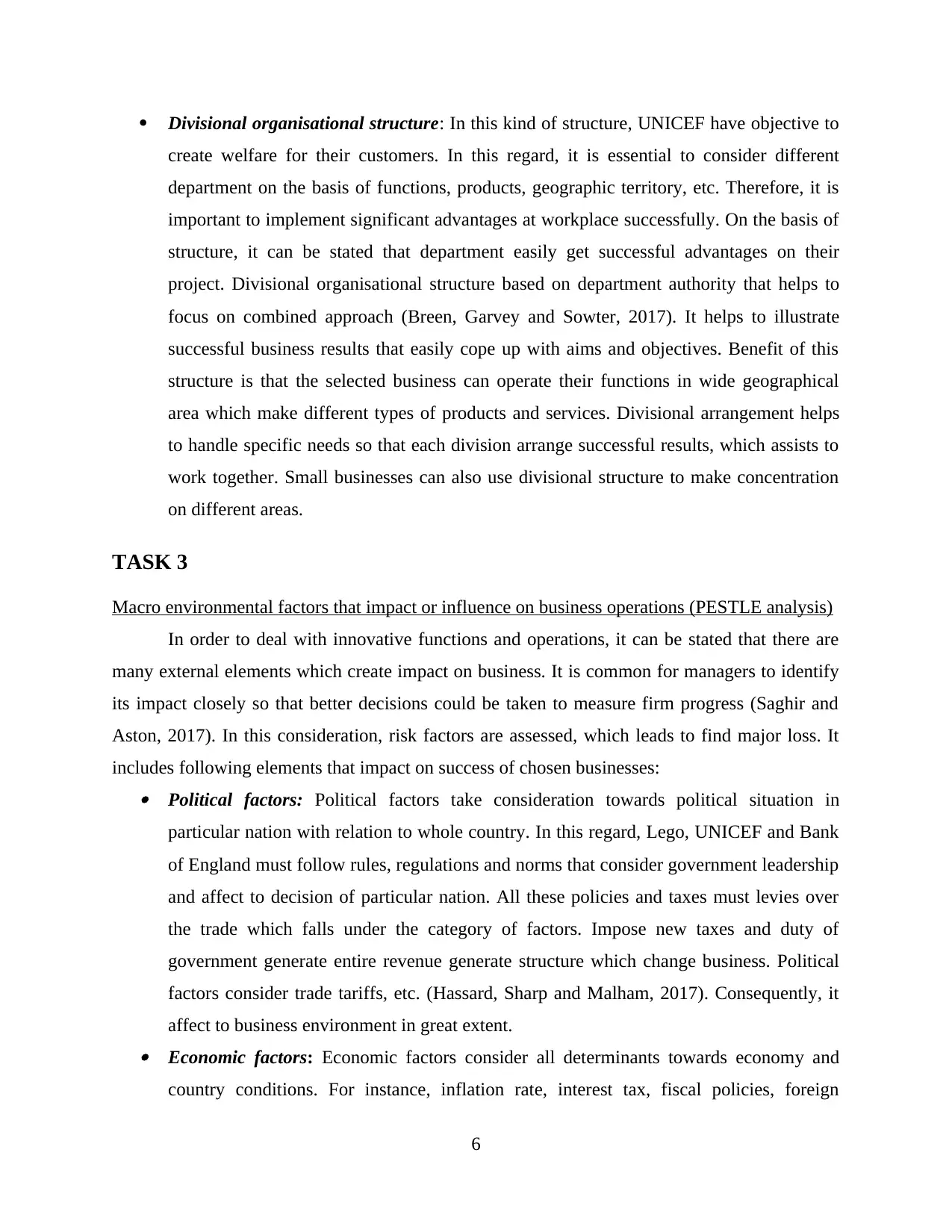
Divisional organisational structure: In this kind of structure, UNICEF have objective to
create welfare for their customers. In this regard, it is essential to consider different
department on the basis of functions, products, geographic territory, etc. Therefore, it is
important to implement significant advantages at workplace successfully. On the basis of
structure, it can be stated that department easily get successful advantages on their
project. Divisional organisational structure based on department authority that helps to
focus on combined approach (Breen, Garvey and Sowter, 2017). It helps to illustrate
successful business results that easily cope up with aims and objectives. Benefit of this
structure is that the selected business can operate their functions in wide geographical
area which make different types of products and services. Divisional arrangement helps
to handle specific needs so that each division arrange successful results, which assists to
work together. Small businesses can also use divisional structure to make concentration
on different areas.
TASK 3
Macro environmental factors that impact or influence on business operations (PESTLE analysis)
In order to deal with innovative functions and operations, it can be stated that there are
many external elements which create impact on business. It is common for managers to identify
its impact closely so that better decisions could be taken to measure firm progress (Saghir and
Aston, 2017). In this consideration, risk factors are assessed, which leads to find major loss. It
includes following elements that impact on success of chosen businesses: Political factors: Political factors take consideration towards political situation in
particular nation with relation to whole country. In this regard, Lego, UNICEF and Bank
of England must follow rules, regulations and norms that consider government leadership
and affect to decision of particular nation. All these policies and taxes must levies over
the trade which falls under the category of factors. Impose new taxes and duty of
government generate entire revenue generate structure which change business. Political
factors consider trade tariffs, etc. (Hassard, Sharp and Malham, 2017). Consequently, it
affect to business environment in great extent. Economic factors: Economic factors consider all determinants towards economy and
country conditions. For instance, inflation rate, interest tax, fiscal policies, foreign
6
create welfare for their customers. In this regard, it is essential to consider different
department on the basis of functions, products, geographic territory, etc. Therefore, it is
important to implement significant advantages at workplace successfully. On the basis of
structure, it can be stated that department easily get successful advantages on their
project. Divisional organisational structure based on department authority that helps to
focus on combined approach (Breen, Garvey and Sowter, 2017). It helps to illustrate
successful business results that easily cope up with aims and objectives. Benefit of this
structure is that the selected business can operate their functions in wide geographical
area which make different types of products and services. Divisional arrangement helps
to handle specific needs so that each division arrange successful results, which assists to
work together. Small businesses can also use divisional structure to make concentration
on different areas.
TASK 3
Macro environmental factors that impact or influence on business operations (PESTLE analysis)
In order to deal with innovative functions and operations, it can be stated that there are
many external elements which create impact on business. It is common for managers to identify
its impact closely so that better decisions could be taken to measure firm progress (Saghir and
Aston, 2017). In this consideration, risk factors are assessed, which leads to find major loss. It
includes following elements that impact on success of chosen businesses: Political factors: Political factors take consideration towards political situation in
particular nation with relation to whole country. In this regard, Lego, UNICEF and Bank
of England must follow rules, regulations and norms that consider government leadership
and affect to decision of particular nation. All these policies and taxes must levies over
the trade which falls under the category of factors. Impose new taxes and duty of
government generate entire revenue generate structure which change business. Political
factors consider trade tariffs, etc. (Hassard, Sharp and Malham, 2017). Consequently, it
affect to business environment in great extent. Economic factors: Economic factors consider all determinants towards economy and
country conditions. For instance, inflation rate, interest tax, fiscal policies, foreign
6
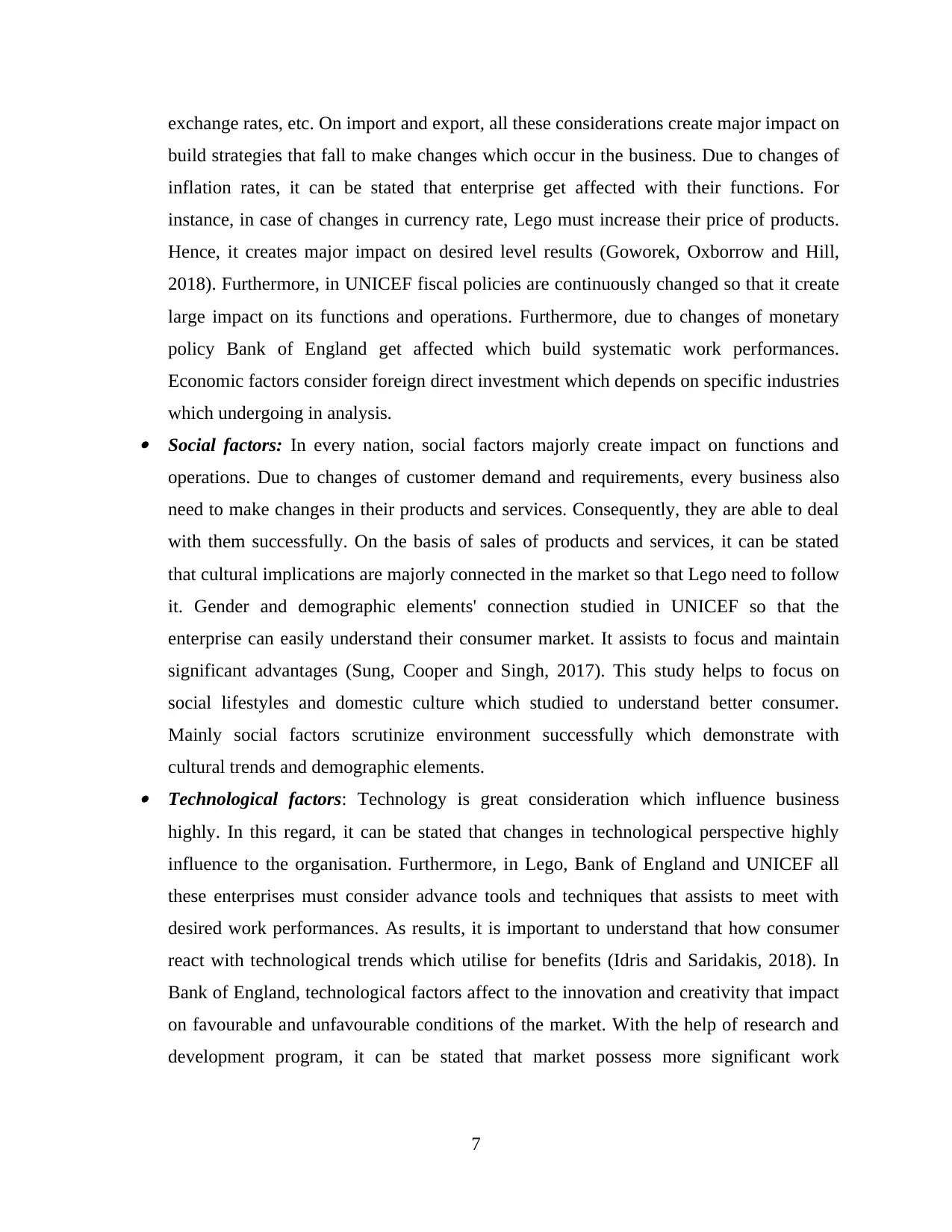
exchange rates, etc. On import and export, all these considerations create major impact on
build strategies that fall to make changes which occur in the business. Due to changes of
inflation rates, it can be stated that enterprise get affected with their functions. For
instance, in case of changes in currency rate, Lego must increase their price of products.
Hence, it creates major impact on desired level results (Goworek, Oxborrow and Hill,
2018). Furthermore, in UNICEF fiscal policies are continuously changed so that it create
large impact on its functions and operations. Furthermore, due to changes of monetary
policy Bank of England get affected which build systematic work performances.
Economic factors consider foreign direct investment which depends on specific industries
which undergoing in analysis. Social factors: In every nation, social factors majorly create impact on functions and
operations. Due to changes of customer demand and requirements, every business also
need to make changes in their products and services. Consequently, they are able to deal
with them successfully. On the basis of sales of products and services, it can be stated
that cultural implications are majorly connected in the market so that Lego need to follow
it. Gender and demographic elements' connection studied in UNICEF so that the
enterprise can easily understand their consumer market. It assists to focus and maintain
significant advantages (Sung, Cooper and Singh, 2017). This study helps to focus on
social lifestyles and domestic culture which studied to understand better consumer.
Mainly social factors scrutinize environment successfully which demonstrate with
cultural trends and demographic elements. Technological factors: Technology is great consideration which influence business
highly. In this regard, it can be stated that changes in technological perspective highly
influence to the organisation. Furthermore, in Lego, Bank of England and UNICEF all
these enterprises must consider advance tools and techniques that assists to meet with
desired work performances. As results, it is important to understand that how consumer
react with technological trends which utilise for benefits (Idris and Saridakis, 2018). In
Bank of England, technological factors affect to the innovation and creativity that impact
on favourable and unfavourable conditions of the market. With the help of research and
development program, it can be stated that market possess more significant work
7
build strategies that fall to make changes which occur in the business. Due to changes of
inflation rates, it can be stated that enterprise get affected with their functions. For
instance, in case of changes in currency rate, Lego must increase their price of products.
Hence, it creates major impact on desired level results (Goworek, Oxborrow and Hill,
2018). Furthermore, in UNICEF fiscal policies are continuously changed so that it create
large impact on its functions and operations. Furthermore, due to changes of monetary
policy Bank of England get affected which build systematic work performances.
Economic factors consider foreign direct investment which depends on specific industries
which undergoing in analysis. Social factors: In every nation, social factors majorly create impact on functions and
operations. Due to changes of customer demand and requirements, every business also
need to make changes in their products and services. Consequently, they are able to deal
with them successfully. On the basis of sales of products and services, it can be stated
that cultural implications are majorly connected in the market so that Lego need to follow
it. Gender and demographic elements' connection studied in UNICEF so that the
enterprise can easily understand their consumer market. It assists to focus and maintain
significant advantages (Sung, Cooper and Singh, 2017). This study helps to focus on
social lifestyles and domestic culture which studied to understand better consumer.
Mainly social factors scrutinize environment successfully which demonstrate with
cultural trends and demographic elements. Technological factors: Technology is great consideration which influence business
highly. In this regard, it can be stated that changes in technological perspective highly
influence to the organisation. Furthermore, in Lego, Bank of England and UNICEF all
these enterprises must consider advance tools and techniques that assists to meet with
desired work performances. As results, it is important to understand that how consumer
react with technological trends which utilise for benefits (Idris and Saridakis, 2018). In
Bank of England, technological factors affect to the innovation and creativity that impact
on favourable and unfavourable conditions of the market. With the help of research and
development program, it can be stated that market possess more significant work
7
⊘ This is a preview!⊘
Do you want full access?
Subscribe today to unlock all pages.

Trusted by 1+ million students worldwide
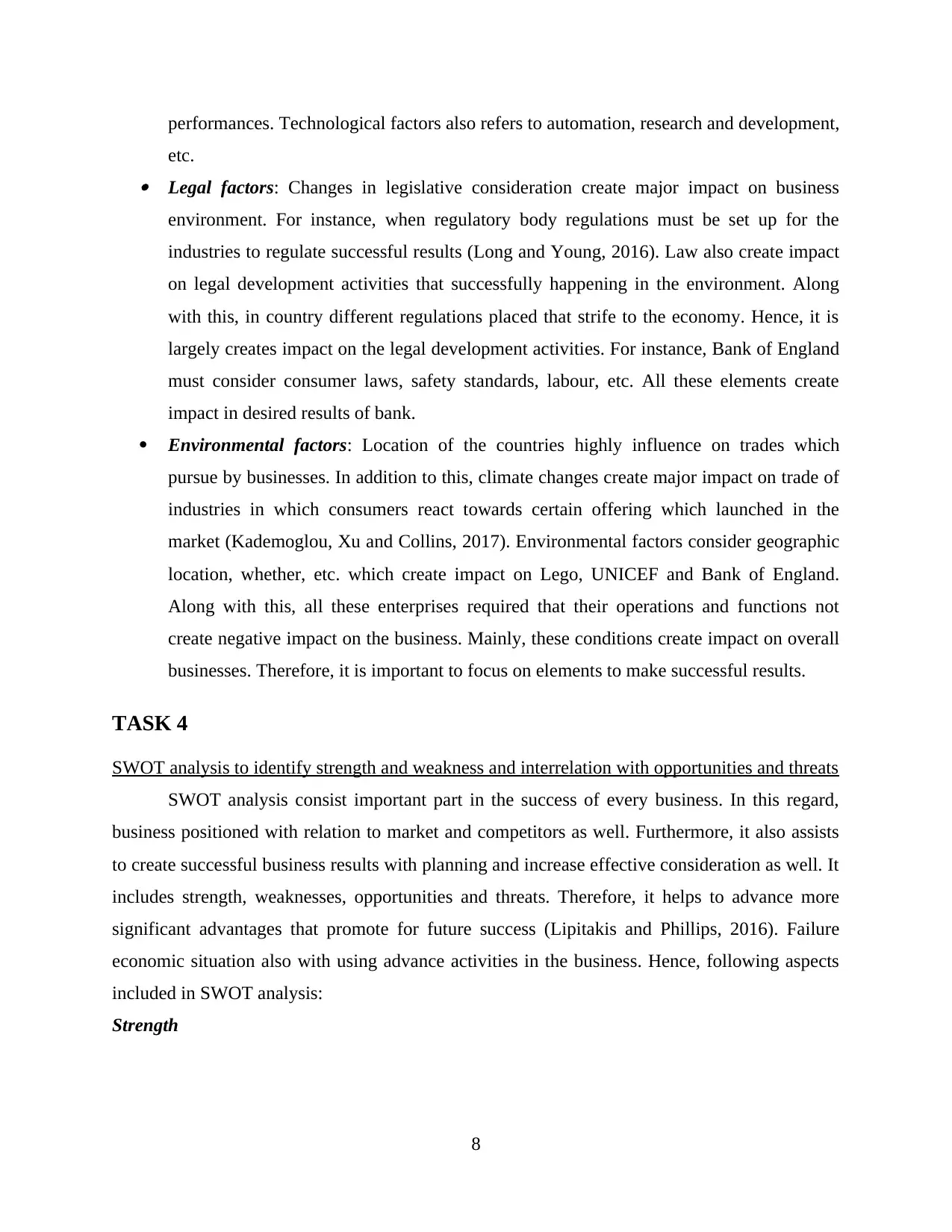
performances. Technological factors also refers to automation, research and development,
etc. Legal factors: Changes in legislative consideration create major impact on business
environment. For instance, when regulatory body regulations must be set up for the
industries to regulate successful results (Long and Young, 2016). Law also create impact
on legal development activities that successfully happening in the environment. Along
with this, in country different regulations placed that strife to the economy. Hence, it is
largely creates impact on the legal development activities. For instance, Bank of England
must consider consumer laws, safety standards, labour, etc. All these elements create
impact in desired results of bank.
Environmental factors: Location of the countries highly influence on trades which
pursue by businesses. In addition to this, climate changes create major impact on trade of
industries in which consumers react towards certain offering which launched in the
market (Kademoglou, Xu and Collins, 2017). Environmental factors consider geographic
location, whether, etc. which create impact on Lego, UNICEF and Bank of England.
Along with this, all these enterprises required that their operations and functions not
create negative impact on the business. Mainly, these conditions create impact on overall
businesses. Therefore, it is important to focus on elements to make successful results.
TASK 4
SWOT analysis to identify strength and weakness and interrelation with opportunities and threats
SWOT analysis consist important part in the success of every business. In this regard,
business positioned with relation to market and competitors as well. Furthermore, it also assists
to create successful business results with planning and increase effective consideration as well. It
includes strength, weaknesses, opportunities and threats. Therefore, it helps to advance more
significant advantages that promote for future success (Lipitakis and Phillips, 2016). Failure
economic situation also with using advance activities in the business. Hence, following aspects
included in SWOT analysis:
Strength
8
etc. Legal factors: Changes in legislative consideration create major impact on business
environment. For instance, when regulatory body regulations must be set up for the
industries to regulate successful results (Long and Young, 2016). Law also create impact
on legal development activities that successfully happening in the environment. Along
with this, in country different regulations placed that strife to the economy. Hence, it is
largely creates impact on the legal development activities. For instance, Bank of England
must consider consumer laws, safety standards, labour, etc. All these elements create
impact in desired results of bank.
Environmental factors: Location of the countries highly influence on trades which
pursue by businesses. In addition to this, climate changes create major impact on trade of
industries in which consumers react towards certain offering which launched in the
market (Kademoglou, Xu and Collins, 2017). Environmental factors consider geographic
location, whether, etc. which create impact on Lego, UNICEF and Bank of England.
Along with this, all these enterprises required that their operations and functions not
create negative impact on the business. Mainly, these conditions create impact on overall
businesses. Therefore, it is important to focus on elements to make successful results.
TASK 4
SWOT analysis to identify strength and weakness and interrelation with opportunities and threats
SWOT analysis consist important part in the success of every business. In this regard,
business positioned with relation to market and competitors as well. Furthermore, it also assists
to create successful business results with planning and increase effective consideration as well. It
includes strength, weaknesses, opportunities and threats. Therefore, it helps to advance more
significant advantages that promote for future success (Lipitakis and Phillips, 2016). Failure
economic situation also with using advance activities in the business. Hence, following aspects
included in SWOT analysis:
Strength
8
Paraphrase This Document
Need a fresh take? Get an instant paraphrase of this document with our AI Paraphraser
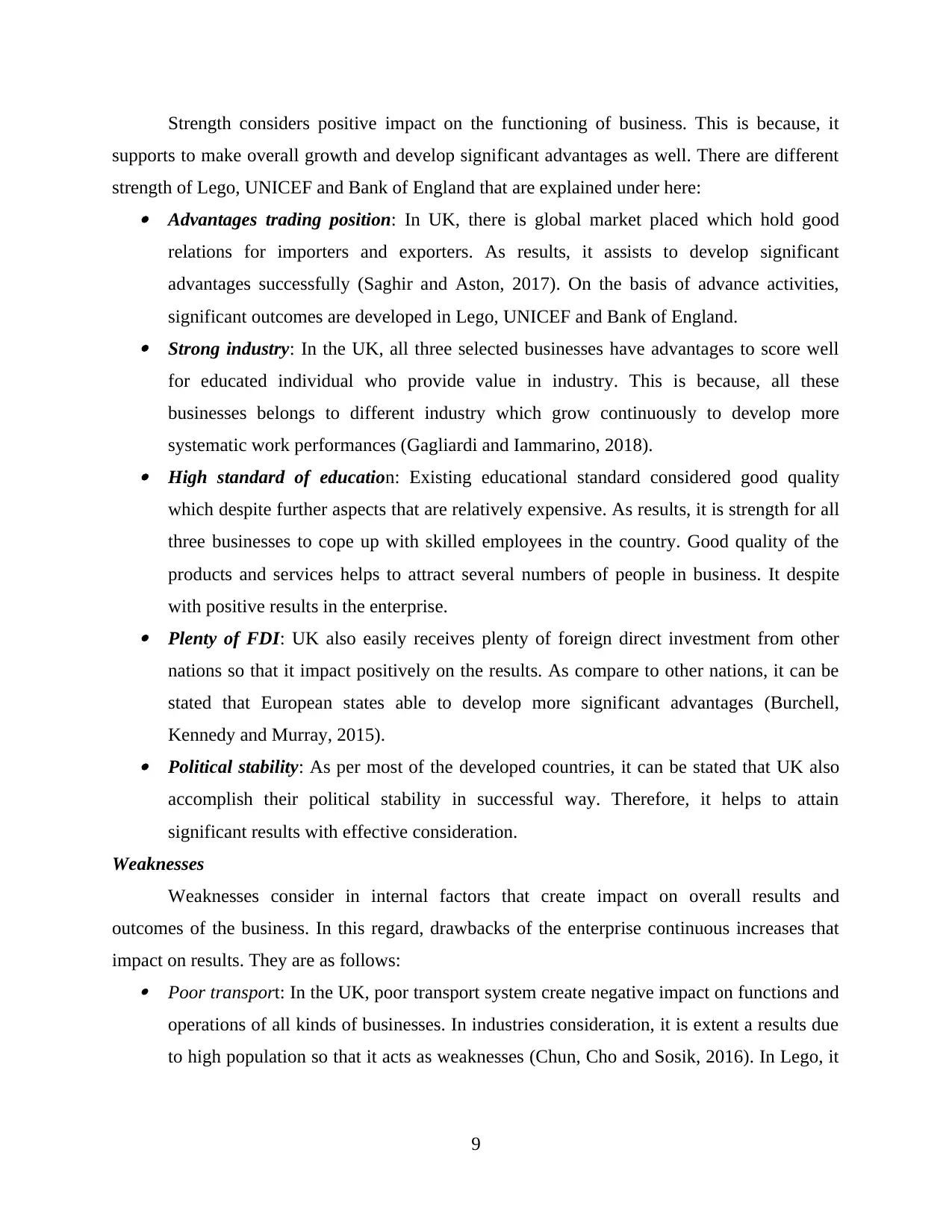
Strength considers positive impact on the functioning of business. This is because, it
supports to make overall growth and develop significant advantages as well. There are different
strength of Lego, UNICEF and Bank of England that are explained under here: Advantages trading position: In UK, there is global market placed which hold good
relations for importers and exporters. As results, it assists to develop significant
advantages successfully (Saghir and Aston, 2017). On the basis of advance activities,
significant outcomes are developed in Lego, UNICEF and Bank of England. Strong industry: In the UK, all three selected businesses have advantages to score well
for educated individual who provide value in industry. This is because, all these
businesses belongs to different industry which grow continuously to develop more
systematic work performances (Gagliardi and Iammarino, 2018). High standard of education: Existing educational standard considered good quality
which despite further aspects that are relatively expensive. As results, it is strength for all
three businesses to cope up with skilled employees in the country. Good quality of the
products and services helps to attract several numbers of people in business. It despite
with positive results in the enterprise. Plenty of FDI: UK also easily receives plenty of foreign direct investment from other
nations so that it impact positively on the results. As compare to other nations, it can be
stated that European states able to develop more significant advantages (Burchell,
Kennedy and Murray, 2015). Political stability: As per most of the developed countries, it can be stated that UK also
accomplish their political stability in successful way. Therefore, it helps to attain
significant results with effective consideration.
Weaknesses
Weaknesses consider in internal factors that create impact on overall results and
outcomes of the business. In this regard, drawbacks of the enterprise continuous increases that
impact on results. They are as follows: Poor transport: In the UK, poor transport system create negative impact on functions and
operations of all kinds of businesses. In industries consideration, it is extent a results due
to high population so that it acts as weaknesses (Chun, Cho and Sosik, 2016). In Lego, it
9
supports to make overall growth and develop significant advantages as well. There are different
strength of Lego, UNICEF and Bank of England that are explained under here: Advantages trading position: In UK, there is global market placed which hold good
relations for importers and exporters. As results, it assists to develop significant
advantages successfully (Saghir and Aston, 2017). On the basis of advance activities,
significant outcomes are developed in Lego, UNICEF and Bank of England. Strong industry: In the UK, all three selected businesses have advantages to score well
for educated individual who provide value in industry. This is because, all these
businesses belongs to different industry which grow continuously to develop more
systematic work performances (Gagliardi and Iammarino, 2018). High standard of education: Existing educational standard considered good quality
which despite further aspects that are relatively expensive. As results, it is strength for all
three businesses to cope up with skilled employees in the country. Good quality of the
products and services helps to attract several numbers of people in business. It despite
with positive results in the enterprise. Plenty of FDI: UK also easily receives plenty of foreign direct investment from other
nations so that it impact positively on the results. As compare to other nations, it can be
stated that European states able to develop more significant advantages (Burchell,
Kennedy and Murray, 2015). Political stability: As per most of the developed countries, it can be stated that UK also
accomplish their political stability in successful way. Therefore, it helps to attain
significant results with effective consideration.
Weaknesses
Weaknesses consider in internal factors that create impact on overall results and
outcomes of the business. In this regard, drawbacks of the enterprise continuous increases that
impact on results. They are as follows: Poor transport: In the UK, poor transport system create negative impact on functions and
operations of all kinds of businesses. In industries consideration, it is extent a results due
to high population so that it acts as weaknesses (Chun, Cho and Sosik, 2016). In Lego, it
9
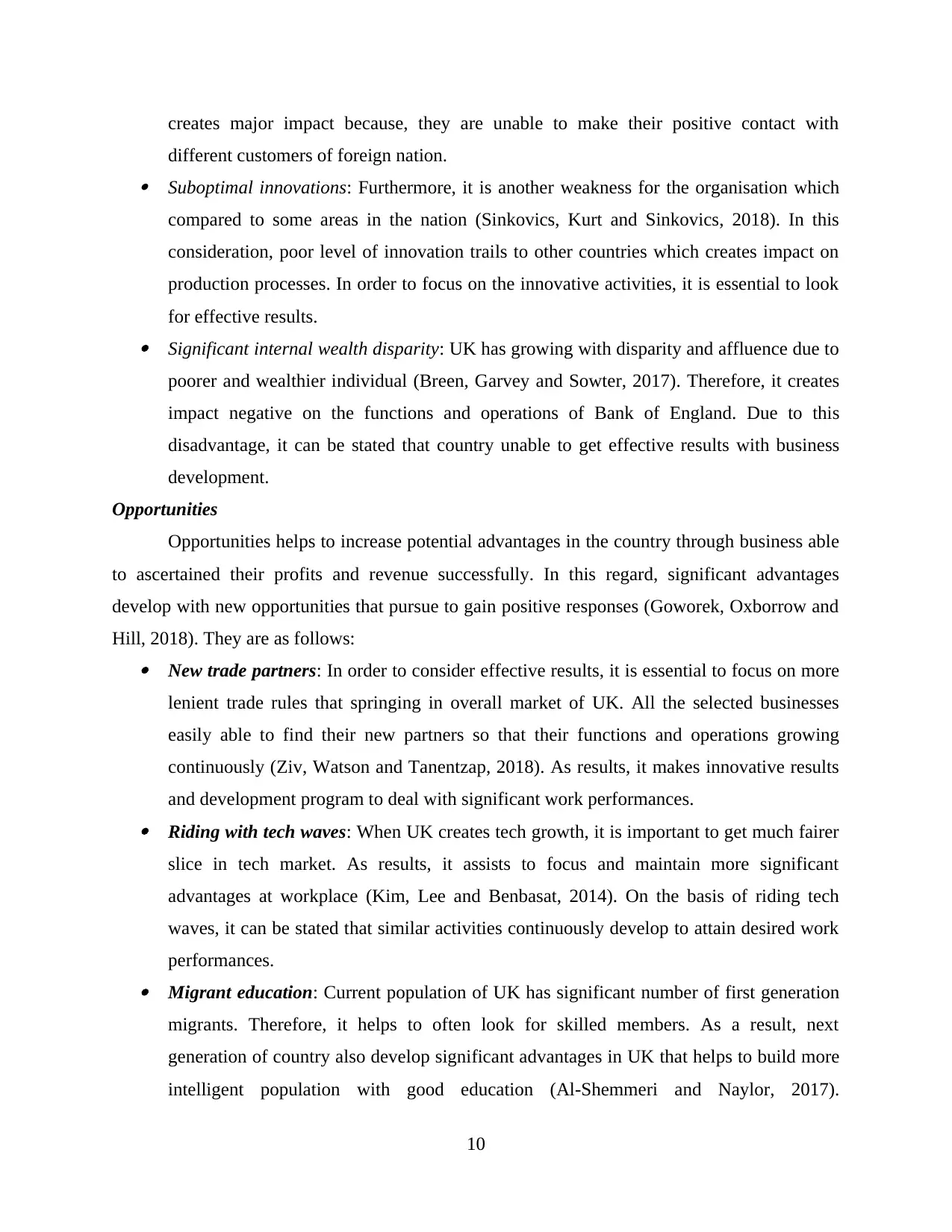
creates major impact because, they are unable to make their positive contact with
different customers of foreign nation. Suboptimal innovations: Furthermore, it is another weakness for the organisation which
compared to some areas in the nation (Sinkovics, Kurt and Sinkovics, 2018). In this
consideration, poor level of innovation trails to other countries which creates impact on
production processes. In order to focus on the innovative activities, it is essential to look
for effective results. Significant internal wealth disparity: UK has growing with disparity and affluence due to
poorer and wealthier individual (Breen, Garvey and Sowter, 2017). Therefore, it creates
impact negative on the functions and operations of Bank of England. Due to this
disadvantage, it can be stated that country unable to get effective results with business
development.
Opportunities
Opportunities helps to increase potential advantages in the country through business able
to ascertained their profits and revenue successfully. In this regard, significant advantages
develop with new opportunities that pursue to gain positive responses (Goworek, Oxborrow and
Hill, 2018). They are as follows: New trade partners: In order to consider effective results, it is essential to focus on more
lenient trade rules that springing in overall market of UK. All the selected businesses
easily able to find their new partners so that their functions and operations growing
continuously (Ziv, Watson and Tanentzap, 2018). As results, it makes innovative results
and development program to deal with significant work performances. Riding with tech waves: When UK creates tech growth, it is important to get much fairer
slice in tech market. As results, it assists to focus and maintain more significant
advantages at workplace (Kim, Lee and Benbasat, 2014). On the basis of riding tech
waves, it can be stated that similar activities continuously develop to attain desired work
performances. Migrant education: Current population of UK has significant number of first generation
migrants. Therefore, it helps to often look for skilled members. As a result, next
generation of country also develop significant advantages in UK that helps to build more
intelligent population with good education (Al-Shemmeri and Naylor, 2017).
10
different customers of foreign nation. Suboptimal innovations: Furthermore, it is another weakness for the organisation which
compared to some areas in the nation (Sinkovics, Kurt and Sinkovics, 2018). In this
consideration, poor level of innovation trails to other countries which creates impact on
production processes. In order to focus on the innovative activities, it is essential to look
for effective results. Significant internal wealth disparity: UK has growing with disparity and affluence due to
poorer and wealthier individual (Breen, Garvey and Sowter, 2017). Therefore, it creates
impact negative on the functions and operations of Bank of England. Due to this
disadvantage, it can be stated that country unable to get effective results with business
development.
Opportunities
Opportunities helps to increase potential advantages in the country through business able
to ascertained their profits and revenue successfully. In this regard, significant advantages
develop with new opportunities that pursue to gain positive responses (Goworek, Oxborrow and
Hill, 2018). They are as follows: New trade partners: In order to consider effective results, it is essential to focus on more
lenient trade rules that springing in overall market of UK. All the selected businesses
easily able to find their new partners so that their functions and operations growing
continuously (Ziv, Watson and Tanentzap, 2018). As results, it makes innovative results
and development program to deal with significant work performances. Riding with tech waves: When UK creates tech growth, it is important to get much fairer
slice in tech market. As results, it assists to focus and maintain more significant
advantages at workplace (Kim, Lee and Benbasat, 2014). On the basis of riding tech
waves, it can be stated that similar activities continuously develop to attain desired work
performances. Migrant education: Current population of UK has significant number of first generation
migrants. Therefore, it helps to often look for skilled members. As a result, next
generation of country also develop significant advantages in UK that helps to build more
intelligent population with good education (Al-Shemmeri and Naylor, 2017).
10
⊘ This is a preview!⊘
Do you want full access?
Subscribe today to unlock all pages.

Trusted by 1+ million students worldwide
1 out of 16
Related Documents
Your All-in-One AI-Powered Toolkit for Academic Success.
+13062052269
info@desklib.com
Available 24*7 on WhatsApp / Email
![[object Object]](/_next/static/media/star-bottom.7253800d.svg)
Unlock your academic potential
Copyright © 2020–2025 A2Z Services. All Rights Reserved. Developed and managed by ZUCOL.





